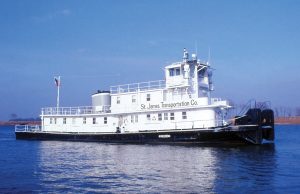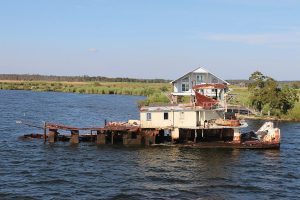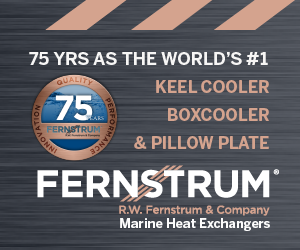Last week, the United States of America celebrated the Fourth of July in honor of the 249th anniversary of the signing of the Declaration of Independence. One towboat that always comes to mind at this time is the Freedom.
Just prior to World War II, Dravo Corporation had turned out two of the most innovative towboats to date. These were the Wm. Penn in 1940 and the near duplicate Ernest T. Weir in 1941. The shipyard’s efforts then turned to churning out vessels for the U.S. Navy, such as sub chasers, minesweepers and many LSTs. Immediately following the war, Dravo set about building towboats that were on the cutting edge of technology at the time. In keeping with this column’s “patriotic” theme, let’s fast forward to a class of boats Dravo built in 1947.
At the end of the war in 1945, the Keystone Sand Division of Dravo had five towboats listed in its fleet. All were diesel, and three were sternwheel. The largest was the 760 hp. Victory, built in 1940 as one of Dravo’s original “porthole” towboats. Dravo completed two larger “porthole” type towboats for Keystone in 1945, as well as two large line haul boats for subsidiary Union Barge Line. Keystone often loaned out one or both of the bigger “porthole” type boats to Union Barge Line.

In 1947, the Victory was sold to the Argentine government and sent to South America. Dravo then began a new series of vessels for the Keystone Division. These boats were specifically designed to run in the Pittsburgh area lock pools and have a slightly raised pilothouse set forward of the upper cabin to clear low bridges. The hull size was 116 by 27 feet, and the twin-screw, kort nozzle boat was powered by a pair of GM 6-278 engines rated at 1,000 hp. turning the shafts through Falk 2.515:1 reduction gears.
The first of the new boats was named Freedom. The name was likely in honor of the town of Freedom, Pa., near Pittsburgh, but also struck a patriotic tone just after a hard-fought war. The new boat went straight to work towing sand and gravel in the Pittsburgh area and became a familiar sight for the next 33 years on the Ohio and Monongahela rivers.
As the bicentennial of the founding of the United States approached in 1976, the Freedom took on a new appearance. Rather than its usual white trimmed in gray and black, the Freedom became a radiant reminder of the upcoming national celebration. The cabin was still painted bright white, but the name of the boat was displayed on the upper deck bulwark in large letters. The upper half of the letters were blue with the lower half in red and white stripes. Blue stars were affixed to the bulwark ahead of and after the letters of the name.
The large single smokestack on the roof of the boat was no longer black, but was now tricolor, with the bottom painted red, the center white and the top blue encircled with white stars. The top of the pilothouse and handrails around that structure were painted blue, as were the visors and search lights. This paint scheme gave the boat a very striking appearance.

In May 1980, the Freedom was sold to a new concern called St. James Transportation Company, Madisonville, La. The Freedom operated as it was for a short time, then was taken in late 1980 to Walker Boat Yard at Paducah, Ky., where it was rebuilt and repowered. When it left the shipyard, it looked like a new boat, with the pilothouse raised and a pair of GM 16V-149 engines and Twin Disc reduction of 6.18:1 that totaled 1,800 hp. The patriotic paint scheme was gone, replaced by a brilliant white with a light gray stack and black hull.
In 1985, the Freedom was again repowered, this time with a pair of Cat 3508 diesels of 1,410 hp.The 1995 50th anniversary issue of the Inland River Record listed the Freedom as still owned by St. James, but with the note “Repo. Whitney National Bank, New Orleans.” That was the last listing for the boat in the IRR, but photos in circulation later depicted it as a landing boat at a private property at Mandeville, La., on Lake Pontchartrain. It sank there and for the past many years has been rusting away, sad and forlorn.
————
Featured photo caption: The Freedom northbound at Henderson, Ky., near Ohio River Mile 804 on August 15, 1980. (Photo by Jeff L. Yates)



